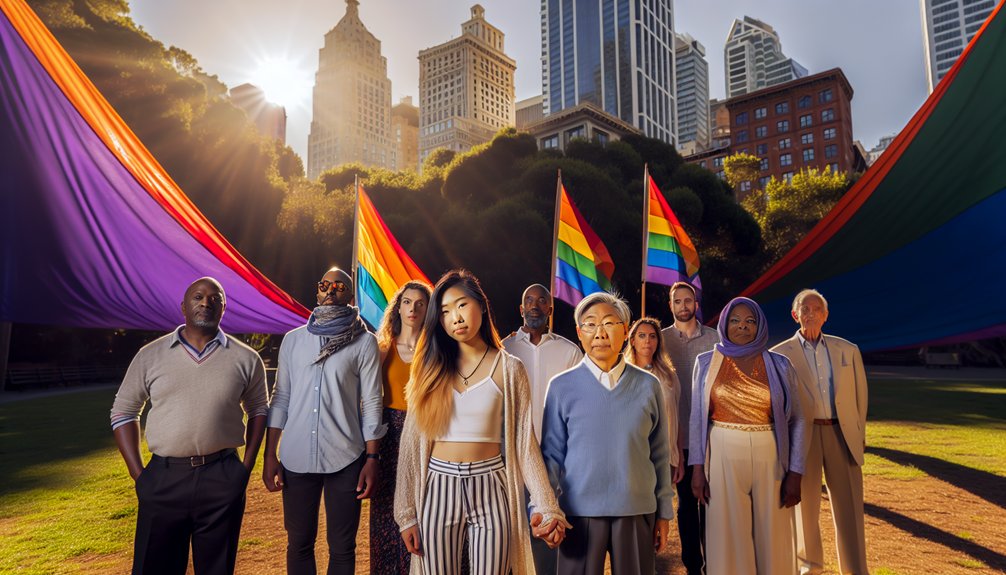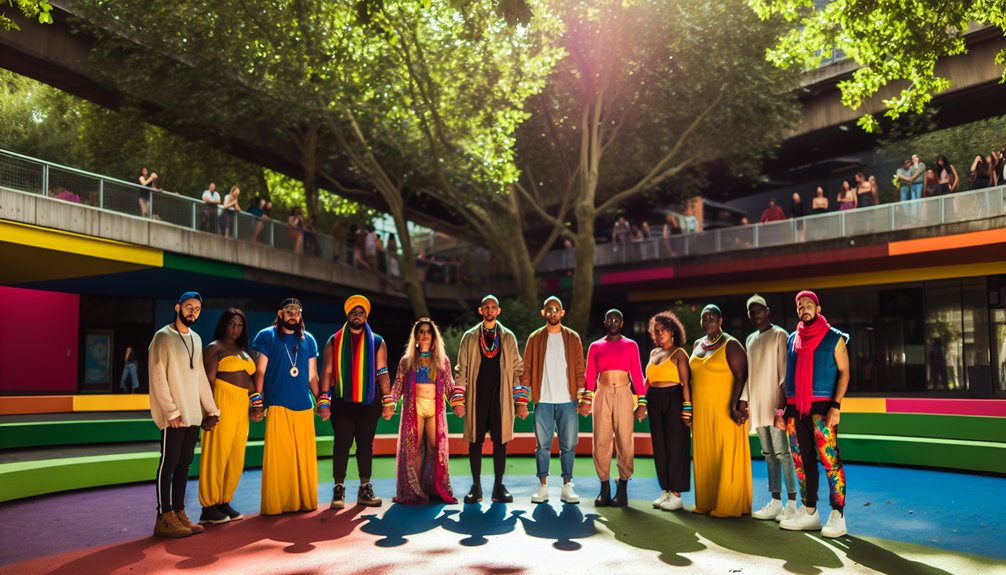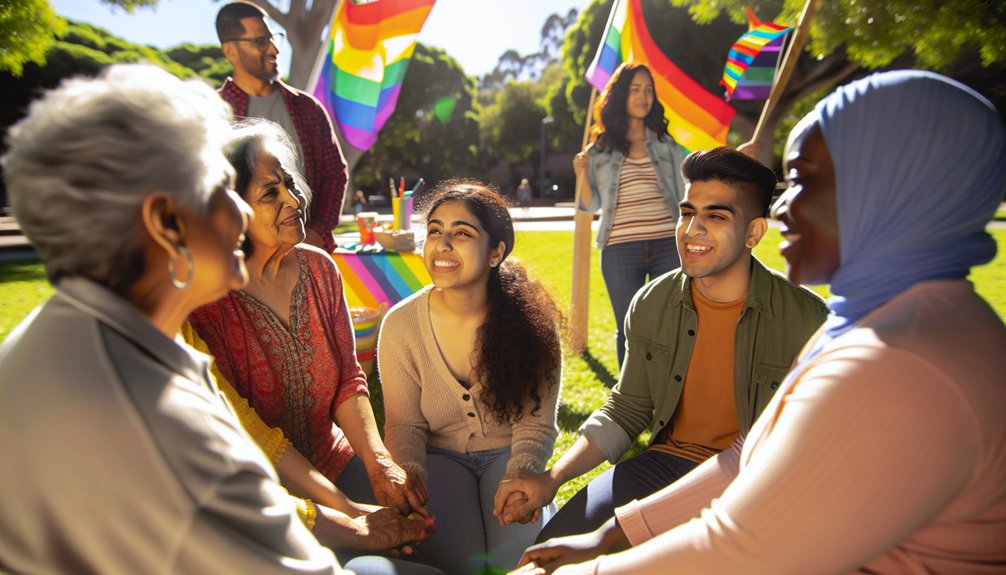Building Resilience: How to Handle Homophobia and Transphobia With Confidence


Table of Contents
ToggleImagine facing a storm with an unyielding umbrella, shielding you from the harsh winds of homophobia and transphobia. Building resilience is like strengthening that umbrella, giving you the confidence to stand tall and proud. It starts with embracing who you are and finding your support network. By practicing self-care and aligning with allies, you can transform adversity into empowerment. Are you ready to investigate how to fortify your inner strength?
Understanding the roots of homophobia and transphobia is crucial in addressing these pervasive issues. You may be curious why these feelings exist. They often come from deep-seated prejudices and fear, reinforced by societal norms and stereotypes that devalue LGBTQ+ identities. This can lead to discrimination, which hurts many people. Sometimes, these negative beliefs become internalized, causing individuals to feel shame or low self-worth. Internalized homophobia can affect mental health, leading to anxiety and depression. It’s significant to recognize that these feelings aren’t your fault. They stem from misinformation and a lack of understanding in society. By learning about these roots, you can begin to challenge them, fostering a more inclusive and accepting environment for yourself and others.

When facing homophobia and transphobia, building personal empowerment and growth becomes essential. Start by embracing your identity and practicing self-affirmation. This helps counter internalized stigma and strengthens self-worth. Engage in mindfulness techniques to manage stress and foster emotional resilience. Surround yourself with a strong support network of friends, family, and allies who affirm your identity. They’re important for your emotional well-being. Participate in LGBTQ+ advocacy to challenge discrimination and build community bonds. This not only promotes inclusivity but also contributes to your personal growth. Lastly, use cognitive restructuring to view rejection as a temporary setback, not a reflection of your worth. By doing so, you can improve your mental health and cultivate a positive self-image.

Embracing your identity lays the foundation for building supportive relationships and networks. When you connect with a community that understands and values you, it provides a sense of belonging and validation. Engaging in LGBTQ+ support groups lets you share experiences and learn coping strategies, helping you feel less isolated. Allies who actively support LGBTQ+ rights can be essential too, as they advocate on your behalf and strengthen your voice. Establishing clear boundaries in your relationships guarantees your emotional well-being by creating a safe space for authenticity. By joining community organizations dedicated to advocacy, you not only build strong ties with like-minded individuals but also promote collective resilience. Remember, a supportive community can be your greatest ally against discrimination.
While education and advocacy are key tools in combating discrimination, they work best when everyone actively participates. By learning about LGBTQ+ issues, you can challenge stereotypes and support inclusive policies. Advocacy isn’t just for professionals; it starts with you. Grassroots campaigns and awareness programs help reduce discrimination and promote acceptance in your community. Schools with inclusive curricula make environments safer for LGBTQ+ students by decreasing bullying and harassment. You can support legal advocacy too, which pushes for anti-discrimination laws. Over 605 anti-LGBTQ+ bills were introduced in 2023, showing the need for continued efforts. Engaging in dialogue and sharing personal stories humanizes LGBTQ+ experiences, fostering empathy and understanding. Remember, your participation makes a difference in creating an inclusive world.
Taking care of yourself is crucial, especially when facing the challenges of homophobia and transphobia. Practicing self-care can help you manage stress and enhance your emotional well-being. Try activities that bring you joy, like spending time in nature or pursuing hobbies. These can serve as healthy distractions from negativity. It’s significant to connect with LGBTQ+ affirming communities and friends who understand your experiences. They can provide support and validation, helping you feel less alone. Establishing strong personal boundaries also protects your emotional health. Regularly practice self-affirmation and positive self-talk to counteract any internalized stigma. These habits will help elevate your self-esteem and reinforce your identity, making you more resilient in the face of discrimination.
You’re stronger than you think when facing homophobia. Start by surrounding yourself with supportive friends and communities. Don’t hesitate to speak up against discrimination, and keep in mind that your feelings are valid. Practice self-care and focus on activities that enhance your confidence. Educate others about LGBTQ+ issues and encourage open conversations. Know that seeking help is okay, and there are resources available to support you. You’re not alone in this path.
To build resilience, focus on self-care and connect with supportive friends and communities. Don’t be afraid to express your feelings and seek out those who affirm you. Practice mindfulness and self-compassion to manage stress. Learn to reframe negative experiences as temporary, and engage in activities that uplift your spirit. Advocacy can also empower you and create positive change. Remember, you’re not alone, and there are always resources to help.
To build resilience against anxiety, focus on practicing mindfulness to stay present and manage stress. Engage in regular exercise to elevate your mood with endorphins. Build a strong support network of friends and allies who understand your experiences. Use cognitive restructuring to reframe negative thoughts, viewing challenges as temporary. Celebrate your identity and strengths through self-affirmation strategies. These steps help improve your resilience, making it easier to navigate anxious moments.
Imagine you’re at a Pride event, surrounded by supportive friends, feeling a strong sense of belonging. That’s queer resilience in action. It’s about embracing your identity, finding strength in community, and standing firm against adversity. You build it by connecting with others who understand your path, celebrating who you are, and challenging discrimination together. This collective strength helps you face life’s challenges with confidence and fosters a more inclusive world.
Remember, you’re not alone in this expedition. By embracing your true self and seeking out supportive communities, you can build the resilience needed to face homophobia and transphobia with confidence. Isn’t it empowering to know that every challenge you overcome only makes you stronger? Practice self-care, educate others, and don’t hesitate to lean on allies. Together, you’re shaping a more inclusive world, one step at a time. Keep going—you’ve got this!
 News and AdvocacyNovember 14, 2025Rainbow Victories: 2025’s Most Pro-LGBTQ+ States Revealed
News and AdvocacyNovember 14, 2025Rainbow Victories: 2025’s Most Pro-LGBTQ+ States Revealed News and AdvocacyNovember 14, 2025Transgender Sanctuary States: Protecting Rights, Providing Hope
News and AdvocacyNovember 14, 2025Transgender Sanctuary States: Protecting Rights, Providing Hope Featured PostsNovember 13, 2025When Restroom Policing Backfires: The Hotel That Went Too Far
Featured PostsNovember 13, 2025When Restroom Policing Backfires: The Hotel That Went Too Far Featured PostsNovember 13, 2025Sex, Safety, and Seduction: A Trans Girl’s Guide to Hookups
Featured PostsNovember 13, 2025Sex, Safety, and Seduction: A Trans Girl’s Guide to Hookups